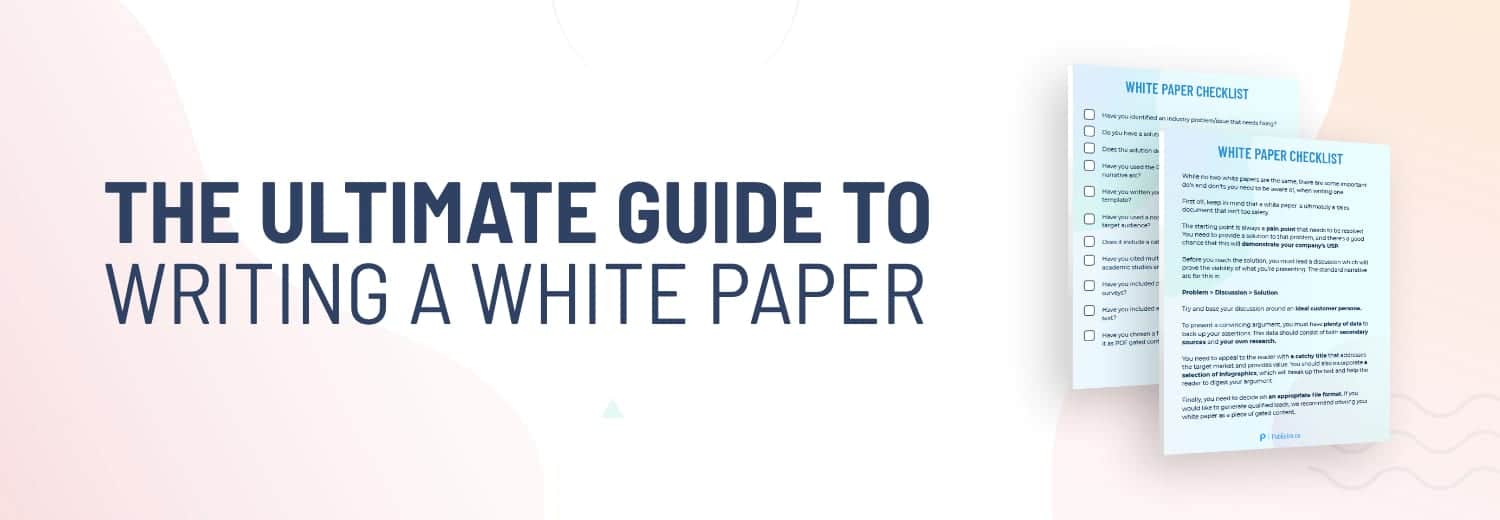If you had to describe writing a white paper with one word, it would be effort. Much like standing at the foot of a mountain or starting a Peter Jackson movie, writing a business white paper can seem daunting.
But while writing a white paper can be time-consuming, when done right they can provide significant benefits to your business.
Here at Publicize we’re fully aware of this, which is why we’ve created this guide to writing a white paper. Lets get started!

What is a white paper
First off, let’s be clear. We’re talking about a business white paper, not a government white paper (that’s a whole other thing!).
So what are white papers in business?
Well, those knowledgeable guys over at Investopedia.com define a white paper as… ‘An informational document, usually issued by a company… to promote or highlight the features of a solution, product, or service’
It elaborates:
‘White papers are often written as sales and marketing documents used to entice or persuade potential customers to learn more about or purchase a particular product, service, technology or methodology.’
That’s a nice and succinct technical definition. But here’s our take on what a white paper is:
It’s a sales document that isn’t overtly salesy.
They’re way more formal and academic in tone, compared to say a typical blog post, brochure or ebook. The narrative also differs from other types of content as a white paper presents a problem to the reader before providing a solution (in the form of a business’s product or service).
Therefore, to build the salesy but not too salesy tone, white papers need to be exhaustive in their research.
The below infographic unpacks the key characteristics of a white paper, compared to Ebooks and blog posts.
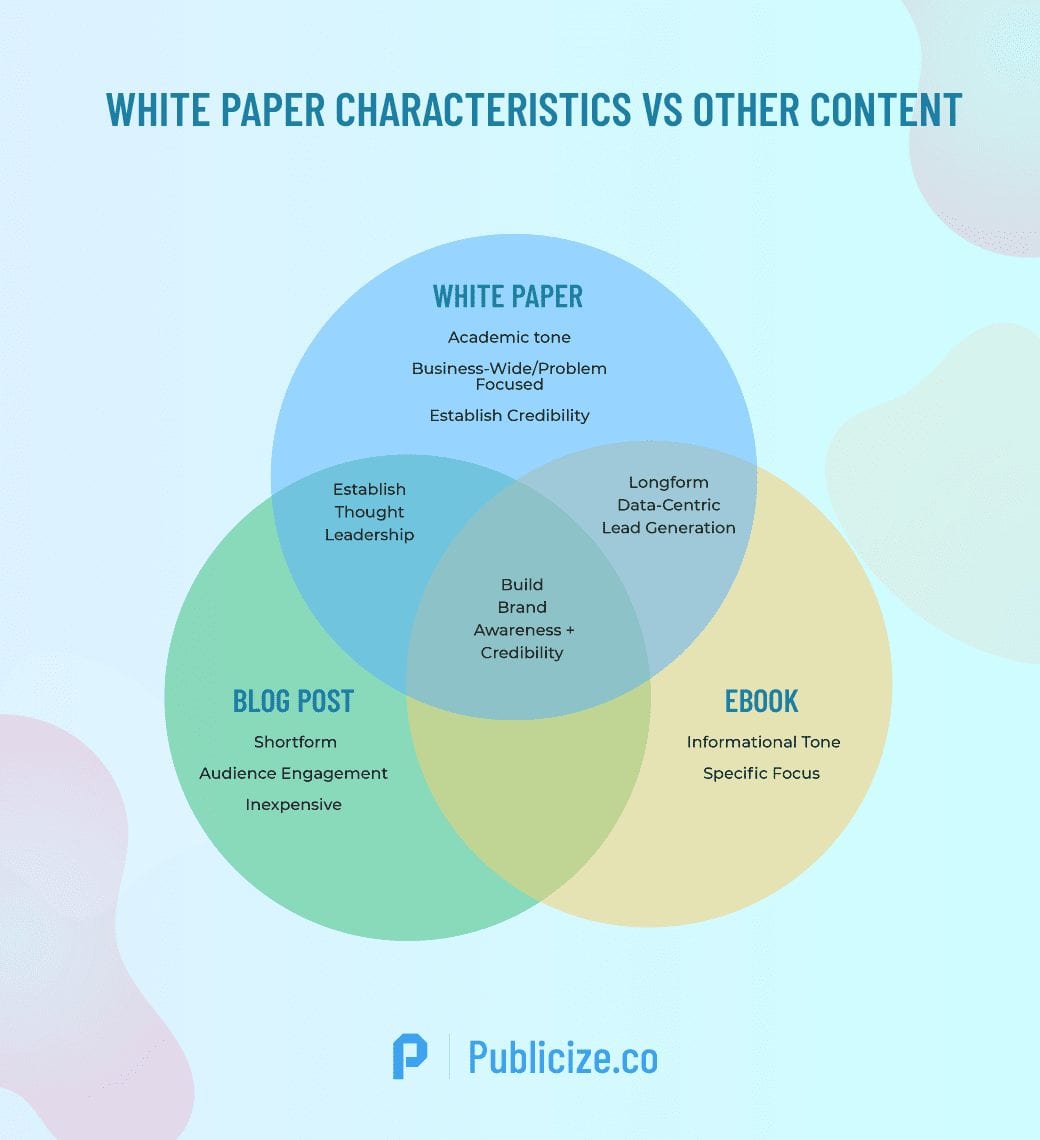
Benefits of a white paper
As we’ve discussed, writing a white paper is a fair investment in both time and energy. So the obvious question you’re probably asking yourself is “what’s going to be my return on this investment?”
Well, the benefits of a well-written white paper can be numerous and long-lasting, as the below infographic shows.
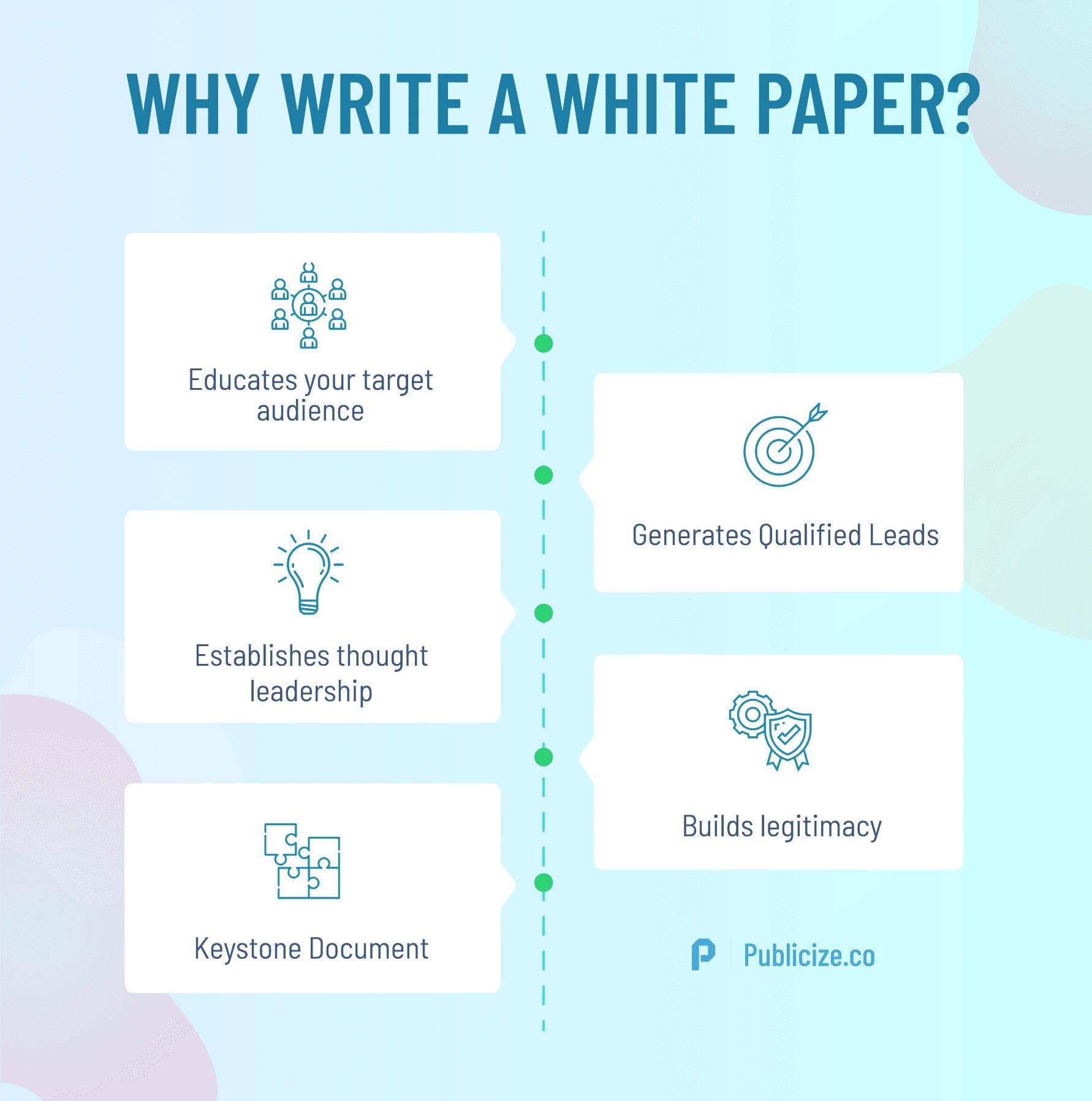
Here’s a break-down of the purpose of a white paper:
- Educate your target audience: A white paper educates the audience on a specific topic, such as a problem they may not have even been aware of. This helps to subtly build your sales argument, by positioning yourself as the solution to the problem.
- Generate Qualified Leads: Most white papers are offered as gated content. This is where you need to provide at least an email address to access it. And hey presto, every time someone accesses it, you’ve captured them as a lead.
- Establish Thought Leadership: By providing your expertise on the topic in hand, you establish yourself as an authority and thought leader within your industry.
- Build Legitimacy: Your white paper is not based on mere speculation. It’s a well-researched document, backed up by data. This builds legitimacy with your target audience.
- Keystone Document: The paper can act as a dossier of the company’s values and objectives. From this, you can develop other, smaller pieces of content such as blog posts and guest articles.
- Build Brand Awareness: This is pretty self-explanatory! Any type of quality online content raises your brand profile.
How to come up with an idea for a white paper
First step of writing a white paper is to come up with a sound idea.
The internet is sadly awash with poorly researched and ill-conceived content marketing documents dressed up as white papers. These provide little-to-no benefit to the company that produced it, as they’re not going to build legitimacy or authority, nor act as an effective sales tool.
Therefore, don’t be tempted to cut corners to save time or money. You’ll simply see no return on your investment.
So, how do you come up with a killer idea for a white paper?
Well first off, think in terms of the standard narrative arc of a white paper:
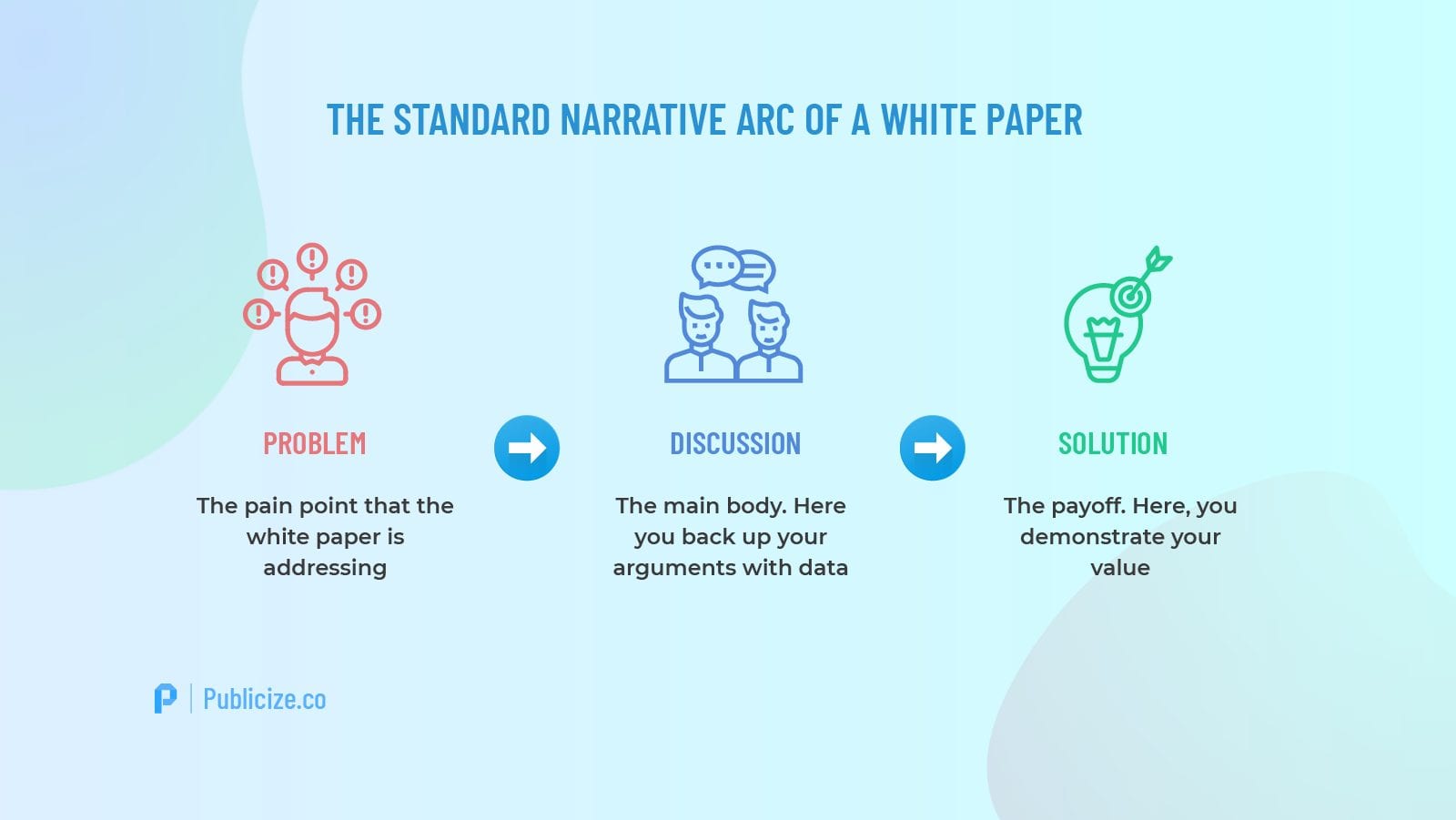
You need to make sure you can wrap your idea around this narrative. It sounds pretty abstract, right? Well, having worked on many white papers for our clients, we’re very aware of this!
That’s why we always start the process by asking the following questions:
- What value does your product provide? What is your USP? How does your product help people? You’ll no doubt already have a clear idea of this if you’re at the stage where you’re planning on writing a white paper.
- What industry problem does this solve? Once again, at this stage, this will probably be something you’re already acutely aware of.
- Who does this benefit? Does your product alleviate pain point(s) of just one user group or multiple groups?
- What is the target audience of your white paper? This is the answer to the previous question. But if your product benefits multiple user groups, do their benefits correlate?
- How can you connect with this target audience? How can you refine your tone to tailor it to your target audience? What is their level of expertise? This will inform how you approach writing your white paper.
Here’s a quick example.
You’re writing a business white paper for a new mobile app you’ve developed. It connects DJs looking for sets, with nightclubs that are trying to fill cancellations. Following the above process…
- Value: You provide value by quickly filling gaps caused by late cancellations and by setting DJs up with more work.
- Problem solved: You solve the issue of club promoters not being able to fill a canceled slot at short notice.
- Beneficiaries: This benefits both club promoters and DJs.
- Target Audience: The target audience of your white paper would be both club promoters and DJs. Their benefits correlate as the service is connecting buyers with sellers.
- How to connect: You can connect with DJs and promoters by making your tone a little less formal, presenting your value, and thoroughly researching the technicalities of the issue (opportunity potential, equipment, compatibility, etc).
Ideal Buyer Personas
You can take this a step further by developing an ideal buyer persona. An ideal buyer persona is essentially a hypothetical avatar of an ideal customer, from within your target market.
They aid marketers in empathizing with prospects and can be very helpful in the development of a white paper. The reason for this is that they can help to create a convincing narrative arc.
You should go into a fair bit of detail when creating your persona. Consider their background, their current situation, their motivations…anything that creates a well-rounded character that the reader will identify with.
This helps you lay out a convincing scenario, featuring a pain point which will affect your persona. You’re then able to resolve this issue, later in the white paper. This adds a human element to the solution you’re selling while keeping the reader intrigued in the narrative you’ve developed.
To continue with the previous example, let’s look at a nightclub promoter.
“David works for a low base salary, but earns a good commission on tickets sold at his events. He’s just had his first child, and things are tight financially. Recently, there have been a few late cancellations, leaving him unable to fill his slots with such a limited timescale. All of the ticket sales have had to be reimbursed, and his reputation has taken a hit. He simply cannot afford another no-show, on either a financial or professional level.”
Example white paper topics
As we have already established, solving the pain points of your target audience is the key for writing an effective business white paper.
To get your creative engines going, here are some examples of how to come up with a white paper topic idea:
–Use something that already works. Turning your most successful blog into a white paper is a sure way to pick a topic that interests your audience.
–Focus on most common themes and objections coming up on sales calls. Having close ties with the sales team can help you identify exactly what your audience wants to read about and where they need more convincing. This is true especially when writing B2B white papers.
–Stay in the loop of changing industry trends. Monitoring the industry trends and picking up any relevant topics within your area of expertise can help you write an effective thought leadership white paper.
–Target valuable transactional keywords. People searching for keywords with commercial intent are ready to make a purchase. This is why these keywords work as great topics for a white paper (as long as they’re relevant to your product and target audience of course).
White Paper Research
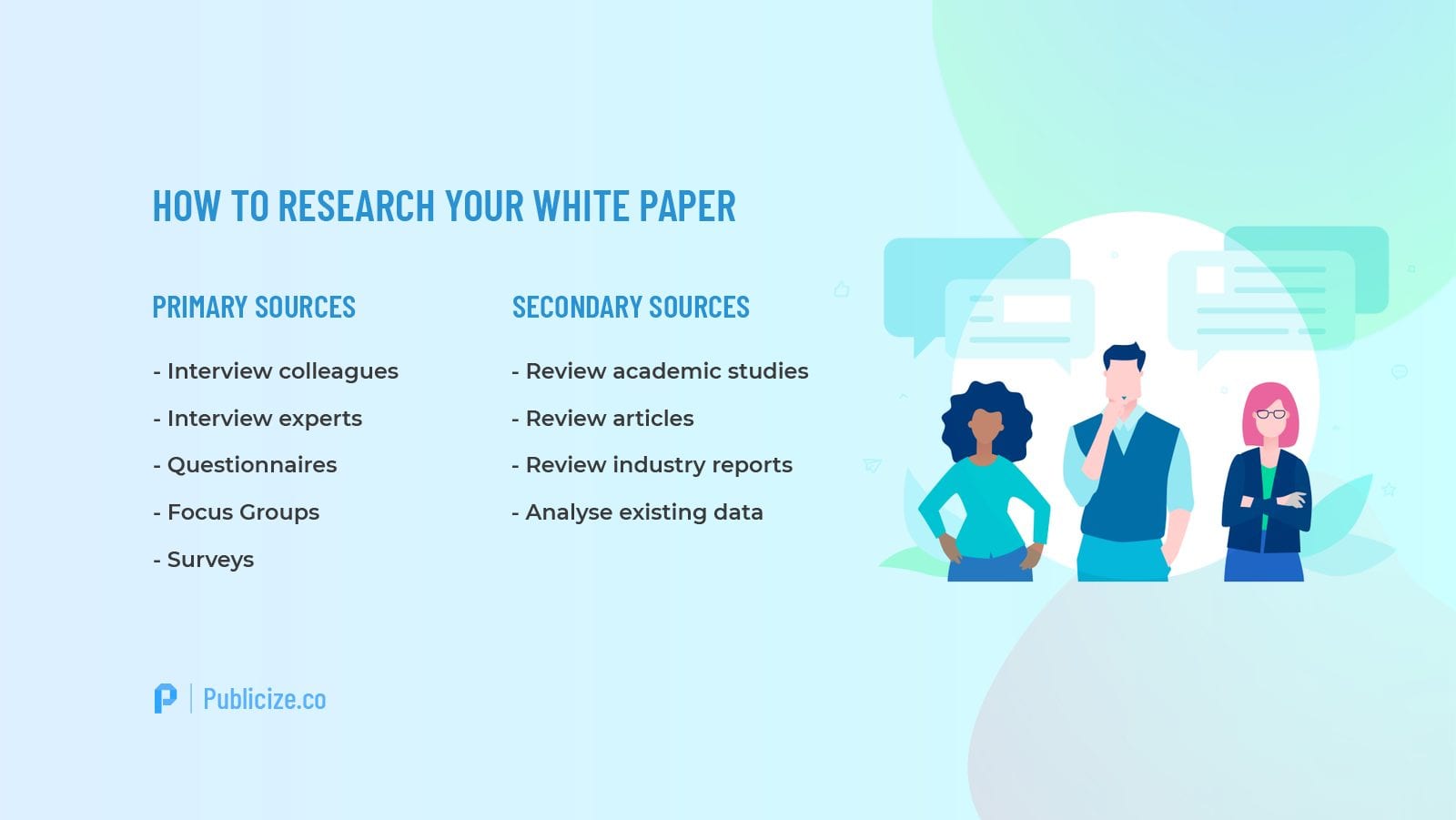
Before sitting down to write a white paper, you need to thoroughly research the subject.
Remember – a white paper is a factual and objective document that provides an unbiased analysis of a subject. Therefore, failure to conduct proper research and gather watertight data points and references will really impede your ability to produce a white paper that will hold up to scrutiny.
Research falls into two categories:
- Primary research: data you’re collected first hand, including surveys, interviews and focus groups.
- Secondary research: a review of existing primary research, including articles, reports and academic papers.
A well rounded, authoritative white paper should contain both primary and secondary research.
Relying exclusively on your own data provides too narrow a viewpoint, whereas failing to conduct primary research reduces your authority on the issue at hand. Primary research also provides you with something trustworthy, unique and up-to-date, while showing that you’re willing to get your hands dirty.
So this being the case, here are some of the ways you can research a white paper:
- Conduct a literature review of industry journals and academic research papers. Referencing this literature in your white paper when developing arguments and analysis will provide the factual and objective underpinning that’s required.
- Interview all relevant internal stakeholders. The knowledge and experience within your business will provide enormous value in terms of developing the angle and arguments presented in your white paper.
- Reach out to industry experts in your professional network. This is a great way to gain original insights from authoritative sources. Offering to provide quotes and backlinks to their websites can be an effective incentive for them to contribute.
- Use focus groups to gain further insight. Curate a guided group discussion on the merits of your product/existing industry problems. The group dynamic can bring out aspects of the topic that you may not have considered
- Conduct an email survey. Send a questionnaire to your existing mailing list. This can be an effective way to gather original data with relatively low cost and effort.
White Paper Template
As a business white paper is formal and academic in tone, it needs to follow a set structure. To get it right, follow this white paper template below.
- Title page/front cover. This will contain the white paper title, your brand name and logo and should be designed to a professional standard (more on the design below).
- Executive summary. This is a paragraph or two that summarizes what your white paper is about and what the main conclusions are.
- Introduction. This provides the setup for the main body and places the white paper within a broader context. It introduces the problem that the white paper will address. It’s vital that you really consider your target audience here, in order to provide the correct level of context.
- Main section. Address each key point individually, under appropriate sub-sections and in detail. Each sub-section could feasibly take up a few pages. You can delve deeper into your persona(s) here.
- Solution. Once you’ve discussed the subject, you then provide the solution to the problem you introduced.
- Conclusion. Here you summarize the main points covered within the white paper and make recommendations relevant to your findings.
- References. Cite the sources that you’ve used while researching and writing your white paper.

How to write a white paper
Now that all of your planning is in place, it’s time to start writing the thing. When it comes to writing a white paper, there are some important considerations to bear in mind.
Title
The title is crucial and needs to:
- Demonstrate the value the white paper provides to readers
- Clarify who the target audience is
- Sound catchy (but not too salesy)
Going back to the example of the DJ booking app, a title could be:
‘Knights of the Turntables: How to Quickly Fill DJ Cancellations and Rescue The Party’
Now that you’ve nailed your title, there’s the small matter of the entire document to contend with! However, by following a logical process, this shouldn’t cause too much panic.
Tone
We’ve mentioned in the introduction and we’ll mention it again here, a white paper should be salesy without being too salesy. Therefore, your tone needs to be academic and objective throughout. But this doesn’t mean it should be dry or overcomplicated.
Infographics
Include plenty of infographics and other visuals in the document.
Reading a white paper can be a bit of a slog, so it’s important to break up dense chunks of text with something a little more visually stimulating. This allows the reader to reset their fatigue before approaching the next section.
It’s also a more effective way of presenting data; summarizing key points, making statistics easier to digest and so on.
Keep to the Structure
There’s a chance you may get a little lost at certain points due to the scope of a white paper. In this event, you should refer to the white paper template. It can help you to regain your focus and segment the white paper appropriately.

White paper format
When it comes to what format your white paper should be in, there are two options which both have their pros and cons:
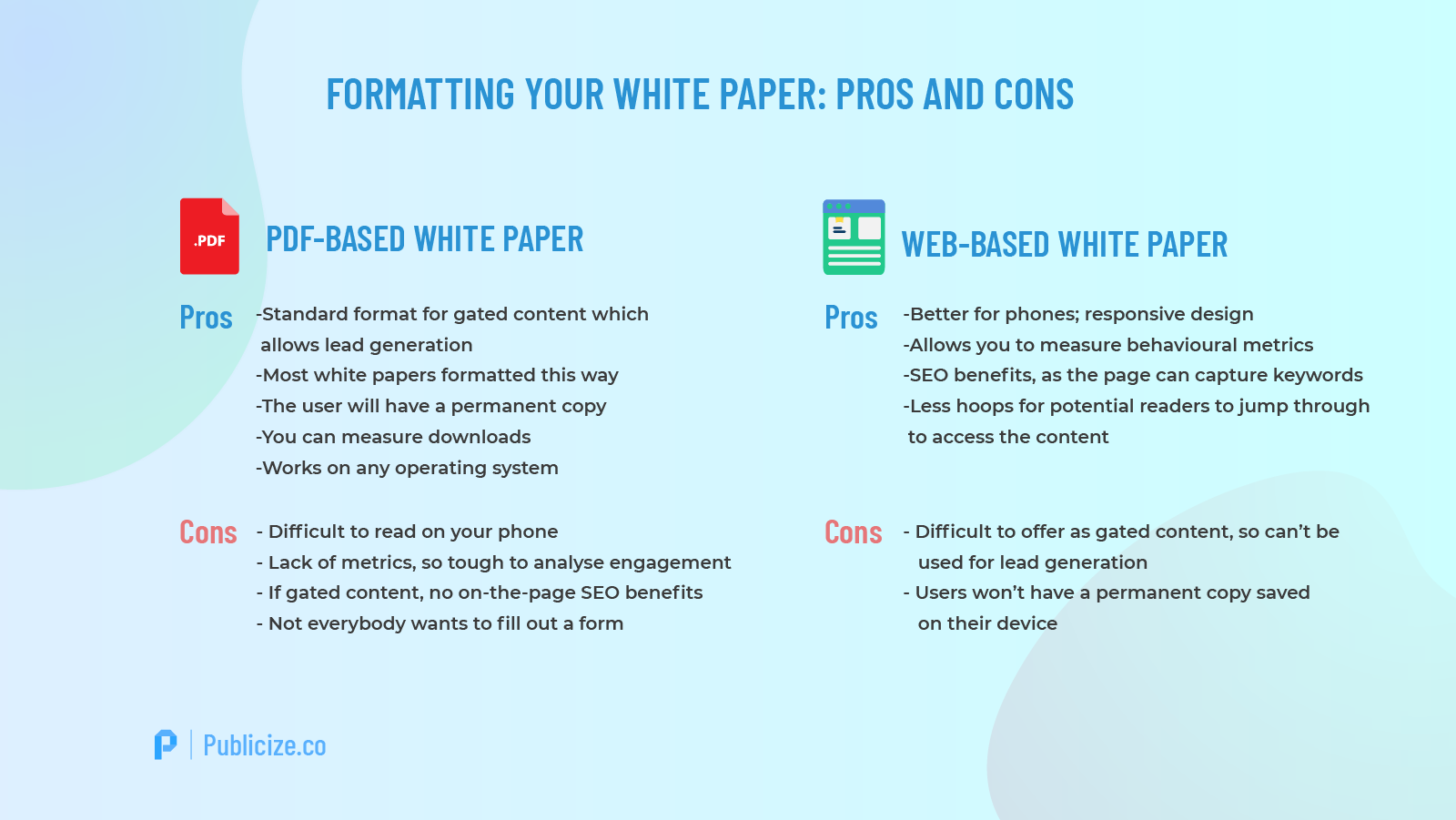
Which white paper format works best for you depends on your objectives.
As you can see, PDF gated content has clear benefits in terms of lead generation. But would you prefer to make the content more accessible and reduce ‘friction’ for the user?
Business white paper examples
To help you with the decision making, here are some successful white paper examples to look at:
–Cybersecurity White Paper Example
White Paper Marketing
As a philosopher may have once said, ‘If a white paper languishes unread, was it ever really written?’ Well, it may as well not have been.
Therefore marketing your white paper is a vital final step.
There are umpteen ways to promote your white paper. The below infographic provides a summary of the main ways you can do this.
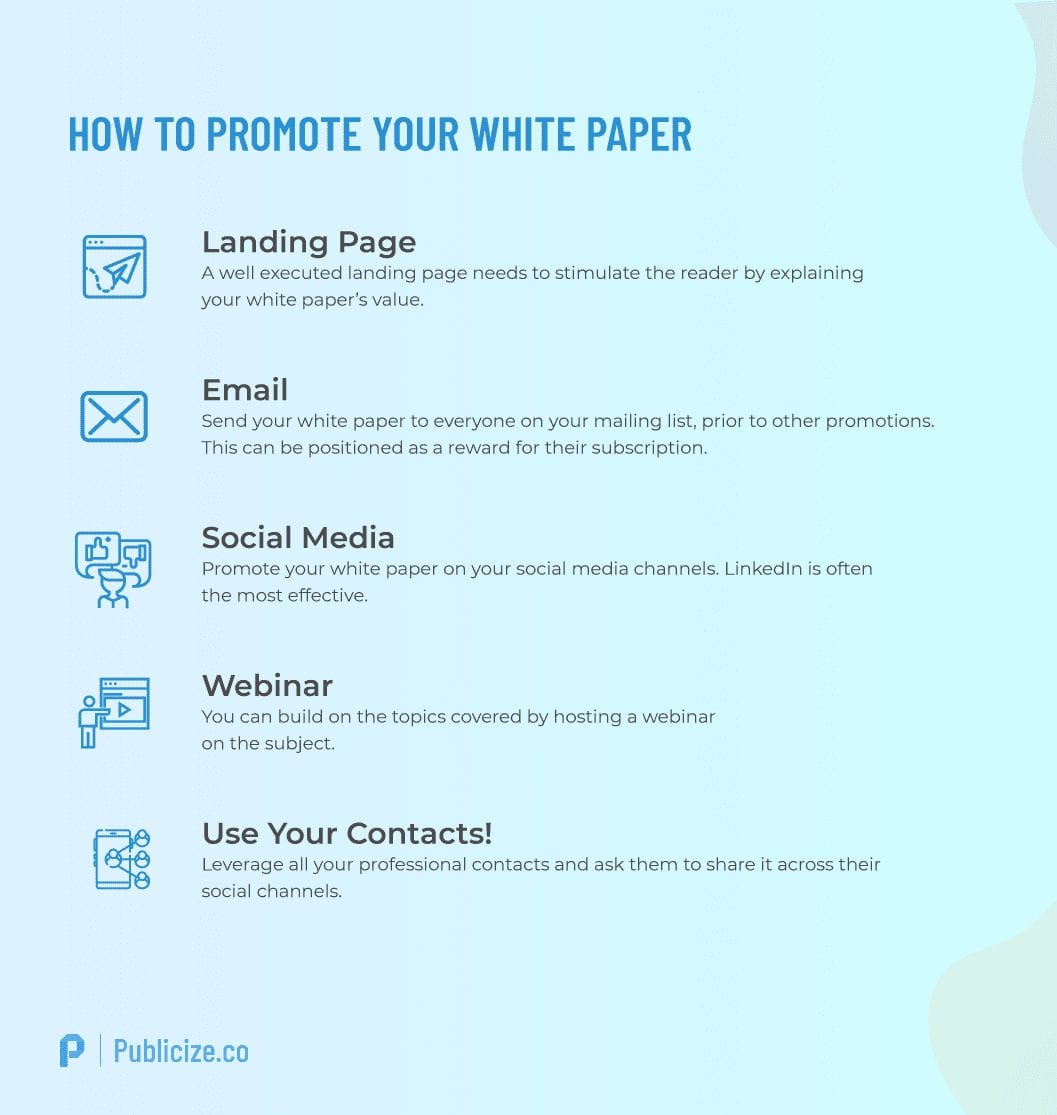
Final Thoughts
You did it! Or you read it, at least. This guide to writing a white paper has walked you through every element of the white paper process; from establishing whether it’s the format for you, to producing that humdinger of a title, all the way to sending your findings out into the world.
If you followed these steps carefully, your business white paper is now ready to go to attract more qualified leads, establish thought leadership and build brand awareness for your company.
That’s quite the triumvirate, and may well have been worth the hard work! Good luck.



